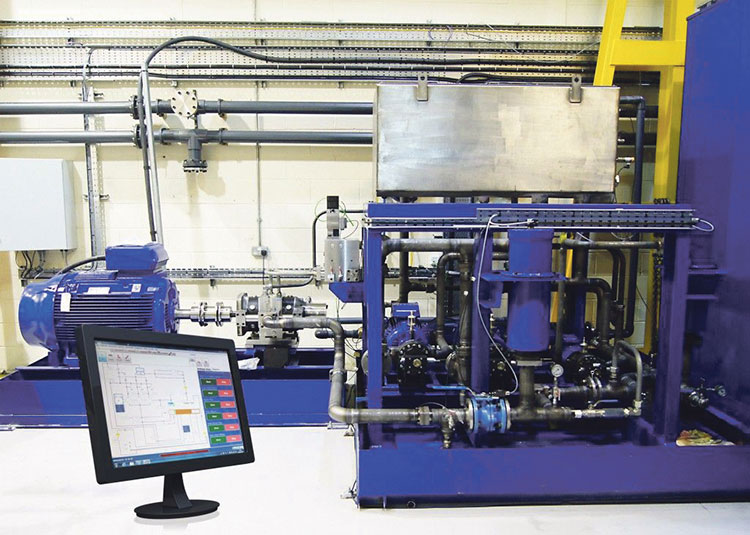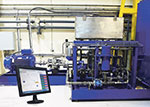Mike Harding, UK Design and Product Development Manager at Oilgear Towler, looks at the benefits of in-house testing for both the manufacturer and the end user when designing and manufacturing electro-hydraulic solutions

Designing and manufacturing electro-hydraulic solutions (pumps, manifolds, valves, controls and systems) requires considerable knowledge and expertise, especially when they are destined for applications in industrial, oil, gas, marine, aviation, civil and military applications where equipment availability is essential.
Using advanced engineering techniques such as solid modelling, Finite Element Analysis and Computational Fluid Dynamics, components can now be designed to meet requirements with minimal need for costly and time consuming testing. But what happens when components currently in production are needed to work in new and challenging conditions? This is where in-house testing facilities ensure that each and every product meets the requirements of the application in which it will be operating.
In many cases, hydraulic equipment is designed and built to meet a wide range of operating pressures and flows, as well as max/min temperature and fluid viscosity conditions covering a wide range of applications. If, however a complete system is required with a unique purpose in mind, the operating parameters may not fall easily within this range, yet each component is still expected to perform reliably with very little maintenance intervention.
With modern hydraulic component design adapted to suit the latest demands, recent years have seen new fluids being developed for specific applications, such as aviation. This industry demands the highest standards of safety and performance, not just in components but from the fluids, which has led to rigorous testing and materials specification programs.
Also, in other industries the requirement for fire-resistant fluids is a common enough situation, but the positive attributes of these fluids may be countered by less desirable traits such as potential corrosive properties. It is therefore essential that a pump or valve is comprehensively tested before it is sanctioned for operation.
One of the most cost effective methods is to utilise in-house testing facilities to validate component operation under (and sometimes beyond) the specific conditions that will be experienced during operation. Testing facilities such as Oilgear’s Multi-fluid test rig, which is specifically designed for use with the existing pump and valve product range, can be modified to enable testing using a range of fluids with varying characteristics. In this way, proven pump designs can be evaluated in terms of performance and reliability with new fluids, ensuring that critical operations are reliably accomplished.
From the end user’s point of view, this approach has the ability to deliver a tested and fully operational pump design, specific to an application, with the minimum of lead times. Working with a proven design, then making some minor design changes to support the characteristics of the new liquid, enables a manufacturer to fast-track the solution.
Furthermore, existing clients may wish to re-assess a pump to work in an existing application where the specification of the pressurised fluid has changed. Oilgear’s comprehensive test facility allows every pump and valve to be tested after manufacture and, if required, document the test results for the client. The original range of test rigs has now been enhanced by a custom-made unit that increases the variety of fluids that can be used to test the manufactured components.
As a manufacturer of hydraulic pumps, valves and manifolds, Oilgear recognises that there may be a requirement to prove the performance and reliability of its products when using less common fluids, and so demonstrate the suitability of each product for specific applications. With this in mind, Oilgear’s engineers have designed and manufactured the latest test rig in-house. This rig is designed to test components under a range of circumstances, with a specific eye on systems using high water based fluids.
This latest addition to the Oilgear test facility allows the scope of operation for a particular product to be widened, making it available to new markets. Products that were originally designed to operate with conventional hydraulic oils can now be reconfigured to work with less conventional fluids such as water-based glycol mixtures, biodegradable fluids and fire resistant fluids.
The pump under test is powered by a 132 kW electric motor, which is controlled by a variable speed drive and used to pressurise the test fluid to a maximum of 700 bar. Three smaller motors are used to provide a pilot supply, a boost supply to the pump and a recirculating flow for the filters and cooler. In each case the fluid properties must be evaluated across a range of temperatures and pressures to ensure that the chosen pump will deliver the required performance. Therefore integral heaters and coolers are used to vary and maintain the temperature of the test fluid between 20 °C and 120 °C.
The rig is controlled by the test operator via an Oilgear designed HMI while operating performance and conditions are monitored by instrumentation recording critical parameters during the test procedure. The fluid and pump combination then undergo a series of predetermined sequences designed to typify the operational characteristics of the new application, with instrumentation data recorded throughout the tests before interpretation to define the boundary parameters for each application.
T 01133 947300
www.oilgear.com


